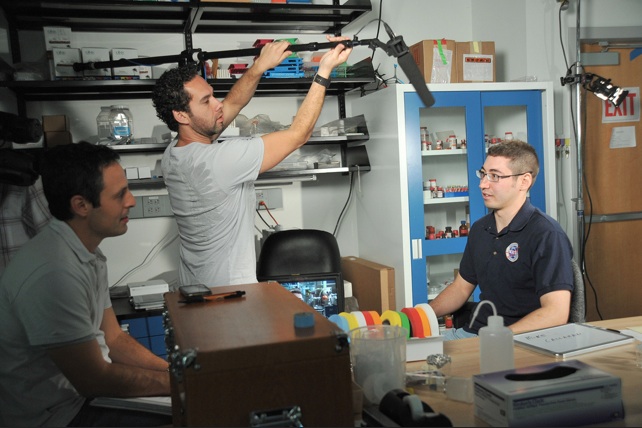You have /5 articles left.
Sign up for a free account or log in.
Michelle Lavery is a Masters student in Biology at the Canadian Rivers Institute and the University of New Brunswick. She was very lucky to have studied rock snot in the PEARL lab at Queen’s University during her undergraduate degree, despite how gross that sounds. You can find her on Twitter @JMichelleLavery.

Once upon a time, I published a paper about rock snot and ended up talking about shag carpeting on the evening news. Shall I explain?
My first publication dealt with a species of algae known as Didymosphenia geminata, commonly known as “rock snot.” It had previously been considered an invasive species, and was worrying a lot of people involved in the salmon fishery on the east coast of Canada. My co-authors and I found that it was, in fact, native to the area, but that climate change was a potential trigger for its sudden appearance in the region. Local news picked this story up and ran with it. For two weeks, I was on call for radio, television, newspapers, and everything else under the sun. It was a whirlwind for which I felt distinctly unprepared. That’s probably why I ended up on CBC talking about 1970s interior design (rock snot looks like shag carpeting when it’s in a river) and calling climate change denial “ridiculous.”
For whatever reason, be it a cute study species or a crazy new archeological finding, someday you may find yourself in the limelight as a result of your research. Erin Bedford wrote an excellent post on how to (not) talk about your research, which is a great starting point for any researcher attempting to communicate with other humans. However, in anticipation of your fifteen minutes of fame, I’ve attempted to use my powers of hindsight to compile a guide to not making a fool of yourself in the media.
Step 1: Prepare a press release
If you and your supervisor agree that your publication may garner some media interest or contains important information for the general public, it is probably worthwhile to prepare a press release. You will need to speak with the media or public relations office at your university, as well as the editors of your academic publication in order to coordinate efforts. It is essential that you are involved in preparing the press release, whether you write it yourself or contribute to the editing process. This release is the first thing media outlets will read about your research, and therefore it is your responsibility to ensure that the information contained within it is correct. That being said, editors and journalists will probably not be familiar with your field’s terminology, so try to keep your press release jargon-free. Finally, if your press release will be sent to media outlets before your research is published, you may wish to embargo it. More resources about writing press releases can be found at Improbable.com, CompassBlogs.org, and the Archosaur Musings Blog.
Step 2: Get everybody on the same page
According to Dr. John Smol, a particularly media-savvy climate scientist and my former supervisor at Queen’s University in Kingston, Ontario, being prepared is key. He suggests writing down a short list of four to five “talking points” or “take-home messages,” and distributing them among your co-authors or research partners. These can be incorporated into your answers to interview questions, and ensure that any contentious issues aren’t misconstrued or confused. He also suggests coming up with a few “quotable quotes” (or tweetable tidbits) which sum up the majority of your research as clearly and concisely as possible. Penny Park, executive director of the Science Media Centre of Canada, agrees that having your main message in a convenient, concise format makes it easier for the journalist to accurately report on your research. She advises that most news stories are very short, and it is important to think about about what you want people to walk away with and remember. It may also be helpful to have a “point person”—an author who will be available upon the release of the research. Ms. Park cautions that many research teams make the mistake of underestimating how much time media attention can take out of a researcher’s schedule. Having a knowledgeable, available “point person” can help alleviate pressure on your co-authors. If the stars align, this person will hopefully have well-developed communication skills too!
Additionally, if you work in conjunction with a government agency, you may want to meet with your research partners and ensure that you are approved to speak with the media. Some agencies may have restrictions on who can speak and what can be said about certain issues. Be sure you understand these restrictions before making a media faux-pas!
Step 3: Know your audience
Dr. Smol suggests answering most questions in a way that can be understood by “an educated public.” Don’t be patronizing, but don’t try to show off by using complicated and confusing jargon. When a journalist initially contacts you, there are a few pieces of information that you should seek out in order to inform the complexity of your answers. For example, an interview with Scientific American may be much more detailed than one with your local small-town newspaper. However, your small-town audience should not feel like they’re in a third-grade science class. The Science Media Centres (in the USA, UK, Canada, Japan, New Zealand, and Australia) have some great resources to help all researchers prepare for interviews and interactions with the media.
Step 4: Only talk about what you know
Have confidence when interacting with journalists—you’re the authority on what you’ve published! However, Dr. Smol has noticed that attempts to answer misguided questions outside a realm of expertise are some of the most common mistakes made by his colleagues. Often, journalists won’t be aware of the extent of your knowledge and it is up to you to ensure that you are only offering information that is pertinent and accurate. Learn how to communicate any uncertainties that may be inherent in your research. Nothing is ever truly off the record, so don’t try to answer uncomfortable questions from left-field—re-pose the question or politely decline to answer instead of speaking above your level of knowledge.
Step 5: Offer your help
Remind the journalist that you are available to answer follow-up questions, or even to briefly look over a draft before they submit to their editors—if that is appropriate. This extra step may ensure that complex concepts are not misconstrued unknowingly, and may prevent the journalist from looking foolish. Don’t be afraid to politely correct journalists in interviews, too. You can easily turn a misguided comment or question into a teachable moment for the audience with a respectful approach and the right tone of voice. This will keep your message clear, while simultaneously making you look gracious and intelligent.
Step 6: Keep a record of everything
Follow up on interviews, and request copies of every interaction you have with the media. Keep a detailed log of all the articles and interviews done about your research—you never know when it could come in handy. Whether you want to show off to your family at Christmas or have to fight off some negative attention, good record-keeping is important when it comes to dealing with the media.
I will leave you with a particularly fabulous resource brought to us by the Australian Science Media Centre: ScienceMediaSavvy.org. Although it caters to scientists, the information they provide can be applied to almost all researcher-media interactions. With that, I wish you all the eloquence in the world—now go forth and be a research rockstar! I dare you to reference shag carpeting in an interview ...
Can you summarize your research in a “quotable quote” or tweetable tidbit? Leave it in the comments or tag it on Twitter with the hashtag #TweetableTidbit.
[Photo by the NASA Goddard Space Flight Center and used under Creative Commons licensing]




